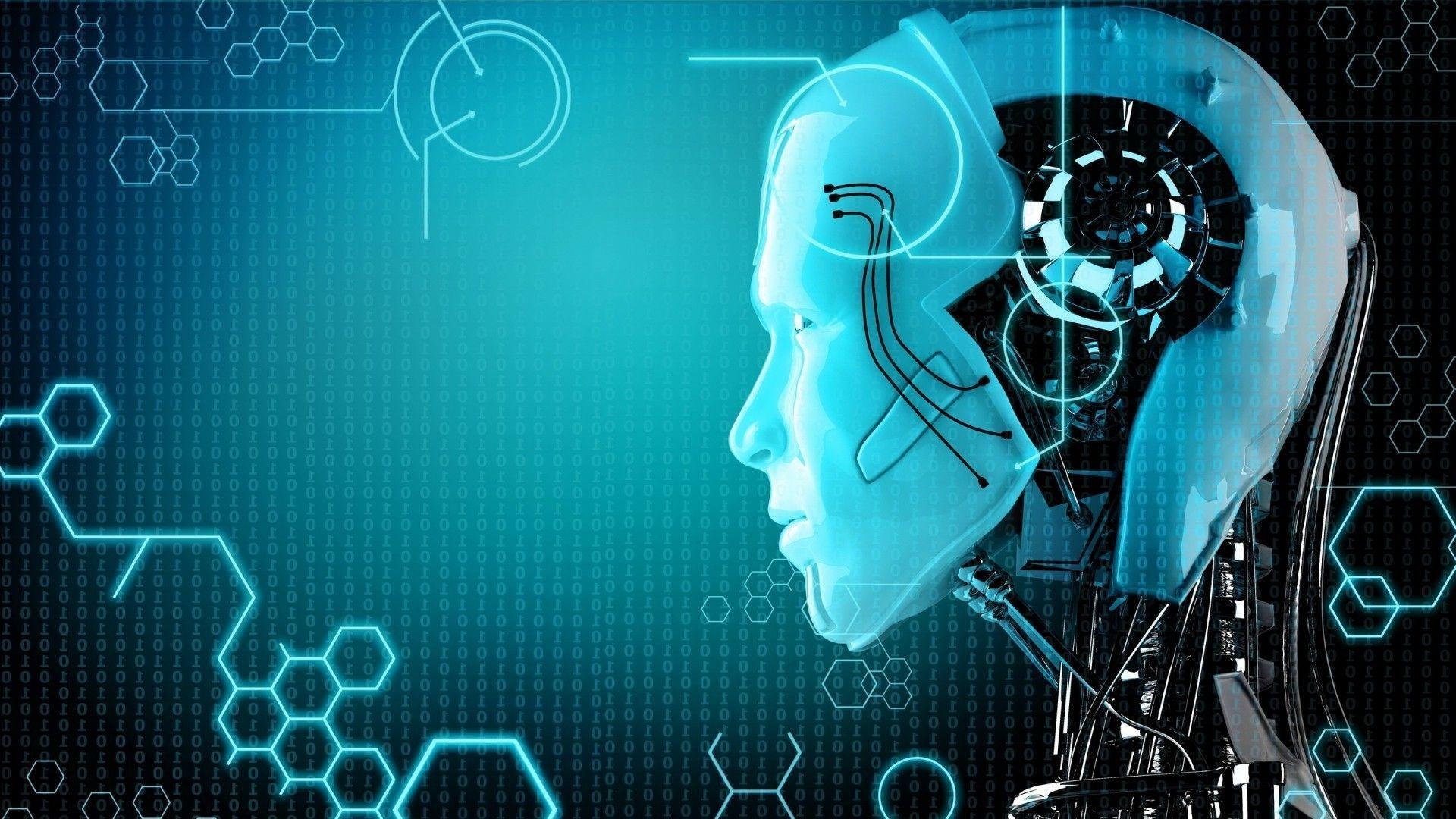We will talk today about artificial intelligence, the intelligence that made people be with their hands. Artificial intelligence is the behavior and specific characteristics of computer programs that make them mimic human mental capabilities and working patterns. Among the most important of these characteristics is the ability to learn, infer and react to situations not programmed in the machine. However, this term is controversial due to the lack of a specific definition of intelligence.
And artificial intelligence is a branch of computer science. Artificial intelligence is defined by many works as "the study and design of smart clients", and a smart customer is a system that absorbs its environment and takes situations that increase its chance of success in achieving its mission or the mission of its team.
This definition, in terms of objectives, actions, perception, and environment, refers to Russell & Norvig (2003) and other definitions also include knowledge and learning as additional criteria. Computer scientist John McCarthy originally coined this term in 1956, and defined himself as “the science and engineering of making smart machines.” Andreas Kaplan and Michael Heinleen define artificial intelligence as "the ability of a system to properly interpret external data, learn from this data, and use that knowledge to achieve specific goals and tasks through flexible adaptation."
This field was founded on the assumption that the intelligence kingdom can be described accurately enough to simulate the machine. This raises a philosophical debate about the nature of the human mind and the limits of scientific approaches, issues that have been discussed in legendary, fictional and philosophical discussions and tales from ancient times. Controversy also revolves around what intelligence and its types a person possesses, and how they simulate a machine. Artificial intelligence was and still is the cause of highly optimistic ideas, and it has suffered severe setbacks throughout history, and today it has become an essential part of the technology industry, bearing the burden of the most difficult problems in modern computer science.
AI research is highly specialized and technical, to the point that some critics criticize the "disintegration" of this field. [7] AI sub-domains revolve around specific problems, the application of special tools and ancient theoretical differences of opinion. Major problems with artificial intelligence include capabilities such as logical thinking, knowledge, planning, learning, communication, perception, and the ability to move and change things. And general intelligence (or “strong artificial intelligence”) remains a far-reaching goal of some research in this field. Artificial justice In the mid-twentieth century, a few scientists began exploring a new approach to building smart machines, based on recent discoveries in neuroscience, a new mathematical theory of information, and the development of cybernetics, and above all, by the invention of the digital computer, a machine was invented that could simulate Human computational reasoning process .
He founded the modern field of artificial intelligence research at a conference on the Dartmouth College campus in the summer of 1956. These attendees have become the leaders of artificial intelligence research for decades, especially John McCarthy and Marvin Minsky, Allen Noel and Herbert Simon who founded artificial intelligence laboratories at the Massachusetts Institute of Technology (MIT), Carnegie Mellon University (CMU) and Stanford. They and their students wrote programs that surprised most people. The computer solved problems in algebra, established logical theories, and spoke English. [12] By the mid-1960s, that research was generously funded by the US Department of Defense. These researchers made the following expectations:
In 1965, H. a. Simon: “Within twenty years, machines will be able to do whatever work a person can do.” 1967, Marvin Minsky: “In one generation ... the problem of creating 'artificial intelligence' will be largely solved.” But they failed to realize the difficulty of some of the problems they faced. [15] In 1974, in response to Sir James Lighthill's criticism of England and the constant pressure from Congress to fund more productive projects, the US and British governments cut their funding for all unearthed exploration in artificial intelligence, the first setback in AI research.
In the early 1980s, AI research saw a new awakening through the commercial success of “expert systems,” which is one of the AI programs that simulates the knowledge and analytical skills of one or more human experts. By 1985 the profits of artificial intelligence research in the market had reached more than $ 1 billion, and governments had started funding again. A few years later, starting with the collapse of the Lisp Machine (one of the programming languages) market in 1987, AI research saw yet another setback, but longer.
In the 1990s and early 2000s, AI has had greater successes, albeit somewhat behind the scenes. Artificial intelligence is used in logistics, data mining, medical diagnosis and many other areas throughout the technology industry. This success is due to several factors: the great power of computers today (see Moore's Law), an increased focus on solving specific sub-problems, and creating new relationships between the field of artificial intelligence and other areas of work in similar problems, and above all, researchers began adhering to strong mathematical approaches And strict scientific standards. It is artificial intelligence that specializes in one field, for example there are systems of artificial intelligence that can beat the world champion of chess, which is the only thing you do.
General artificial intelligence modified This type refers to computers with a level of human intelligence in all areas, i.e. it can perform any intellectual task that a person can perform. Creating this type of intelligence is much more difficult than the previous type and we have not reached this level yet.
Super artificial intelligence modified Oxford philosopher Nick Bostrom defines supreme intelligence as “an idea that is much smarter than the best of human minds in almost every field, including scientific creativity, general wisdom, and social skills.” Because of this type, the field of artificial intelligence is an interesting field for in-depth exploration. The 21st century, AI research has become highly specialized and technical, and it has been divided into deeply sub-independent domains that they are so few to each other. [138] The field sections grew around specific institutions, researchers worked, on solving specific problems, and differences of opinion a long time ago emerged over how artificial intelligence should work and the application of various tools on a large scale. The problem of simulating (or creating) intelligence is divided into a number of specific sub-problems. These consist of certain features or capabilities that researchers would like embodied in an intelligent system. The features listed below received the most attention.
Conclusion, logical reasoning, and ability to solve problems The first researchers in artificial intelligence developed algorithms that simulate the logical, logical reasoning that humans do when solving puzzles, playing table or logical conclusions. In the 1980s and 1990s, AI research led to very successful methods of dealing with uncertain or incomplete information, using concepts of probability and economics.
For difficult problems, most of these algorithms require massive arithmetic resources - leading to a "fusion explosion": meaning that the amount of memory or time required for computers becomes sidereal when the problem exceeds a certain size. The search for more problem solving algorithms is a top priority for AI research.
Humans solve most of their problems by using quick, intuitive, and not conscious judgments, by a gradual deduction that enables the first researchers of artificial intelligence to simulate it automatically. Artificial intelligence research has made some progress in imitating this "sub-symbolic" type of problem-solving skills: the approaches involved include ensuring the importance of kinesthetic skills for superior thinking; research in the field of neural networks tries to simulate structures within the human and animal brain that lead to the emergence of This skill.
Knowledge representation Crystal Clear app kdict.png Detailed articles: Knowledge representation, intuitive knowledge Knowledge representation and knowledge engineering [36] are the focus of artificial intelligence research. Many of the problems that a machine is expected to solve will require extensive knowledge of the world. Among the things that artificial intelligence needs to be represented are: things, properties, taxonomic groups, and relationships between things; situations, events, states, and time; [38] causes and consequences; knowledge of knowledge (what we know what people know) And many other areas that did not receive enough research. A full representation of "what exists" is called ontological (existential) [41] (a word borrowed from ancient philosophy), and the most comprehensive of them is called higher anthologies.
Among the most difficult problems in representing knowledge are:
Virtual thinking and qualification problem Much of what people know are "assumptions." For example, when mentioning birds in a conversation, a person's brain usually depicts an animal the size of a fist, singing, and flying. Of course, not all of these specifications apply to all birds. John McCarthy knew this problem in 1969 [42] with the problem of qualifications: for every logical rule that AI researchers are interested in representing, there are many exceptions. Almost nothing can simply be said to be real or not in the way it requires





